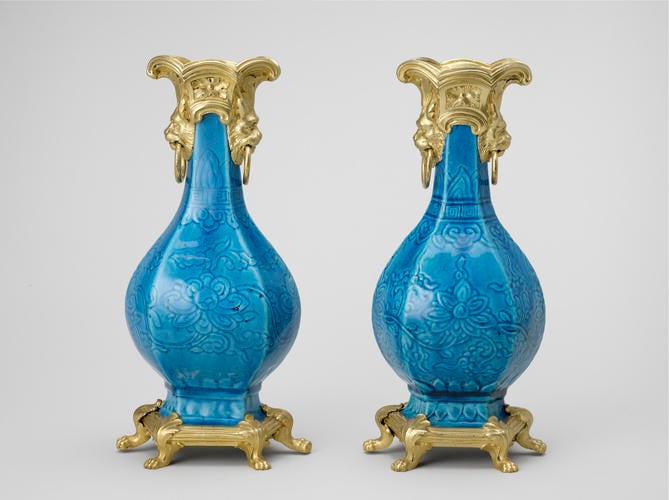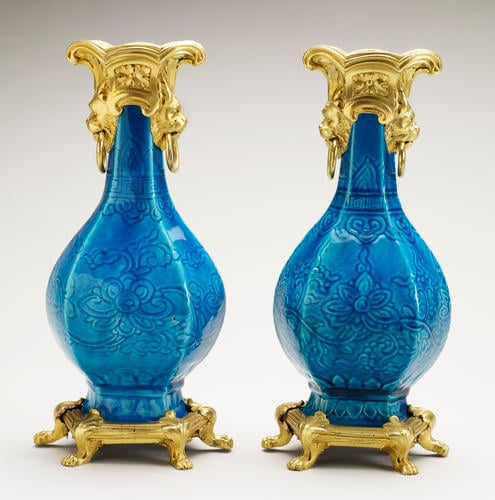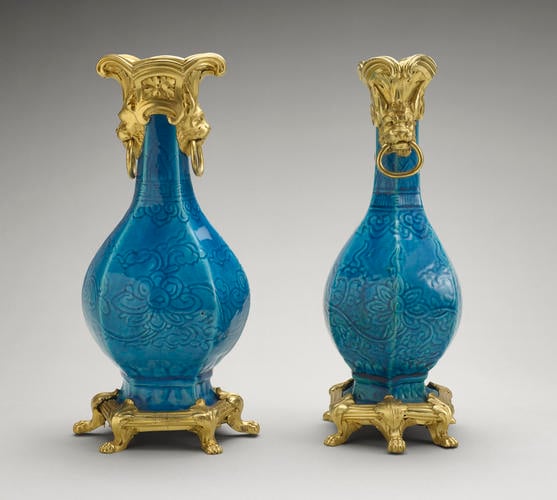Pair of vases with mounts vases: early 18th century, mounts: 1750-75
Porcelain with turquoise glaze and incised decoration and gilt bronze | 26.5 x 13 x 10 cm (whole object) | RCIN 475
-
A pair of early eighteenth-century hexagonal turquoise glaze Chinese porcelain vases. Of flattened hexagonal form, pear-shaped with tapering neck and spreading foot. Carved round the sides with a lotus-scroll design, a key-fret border round the neck, with ruyi-head frieze below and stiff leaves above, and petal border round the foot. The top rim of each bottle is entirely encased in a six-sided deep cup of waved, arched profile, with reeded edge above a rectangular foliate panel on each long face, and a winged lion-mask with loose ring handles at each side. The six-sided foot sits in a reeded band, on foliate paw feet at each angle; the central feet of each side cover the unattached parts of the mounted foot; with a copper plate covering the underside. The gilt-bronze mounts are French, made in the third quarter of the 18th century.
On 16 May 1814, Benois bought in Paris ‘5 Vazes ancien Blue [sic] celeste de la Chine montés’ for 1170 francs (Royal Archives GEO/MAIN/26407). In July, they were received at Carlton House, and four were placed on one of the Weisweiler pier tables in the Chinese Room. Several pairs of vases of bleue [sic] céleste d’ancien la Chine were included in the sale of the famous collection of the fermier-générale, Randon de Boisset (1708–76), in 1777. Although it is not possible to confirm a link, the description and size of lot 626 in this sale corresponds closely to these vases.
Turquoise glazes, Islamic in origin, are found in Chinese pottery from the Song period (960–1279) onwards. Used later on porcelain, they were, as a rule, applied to a biscuit fired body and baked at medium temperatures. These wares were especially admired in France in the eighteenth century when the glaze was known as bleu celeste, and were favoured by Queen Marie Antoinette.Text adapted from Chinese and Japanese Works of Art in the Collection of Her Majesty The Queen, Volume II.
Provenance
Almost certainly George IV. A pair was delivered to the Royal Pavilion, Brighton, on 27 March 1819 (Jutsham Recs I.321; Jutsham Dels I.310); and a ‘pair of turquoise blue hexagon shaped China Bottles, impressed flowers and borders, mounted shaped lips and masks & ring handles of ormolu, ormolu bases & leaf paw feet, ten inches [25.4 cm]’ is recorded at the Lord Steward’s Apartment, the Royal Pavilion, Brighton (1829B, p. 94); sent in March 1847 to Buckingham Palace (1829A, p. 31), and later noted in the 1877 Buckingham Palace China Inventory, p. 133.
Exhibited in Carlton House: The Past Glories of George IV’s Palace, The Queen’s Gallery, London, 1991–2. -
Creator(s)
(nationality)(metalworker)(nationality)Acquirer(s)
-
Medium and techniques
Porcelain with turquoise glaze and incised decoration and gilt bronze
Measurements
26.5 x 13 x 10 cm (whole object)
Other number(s)











